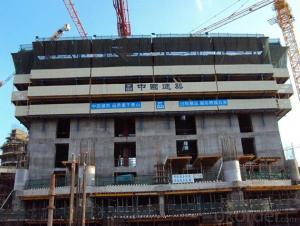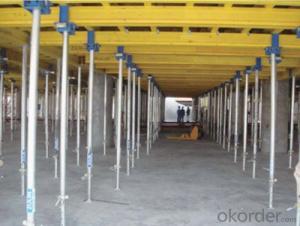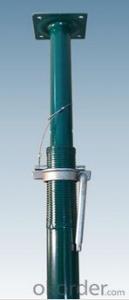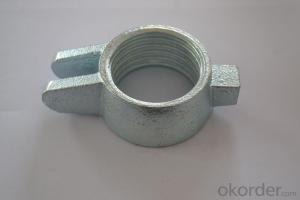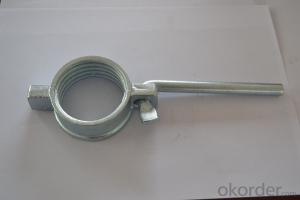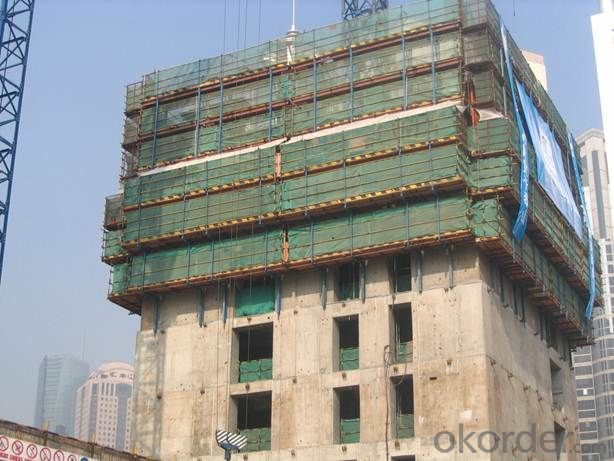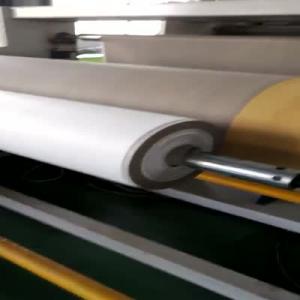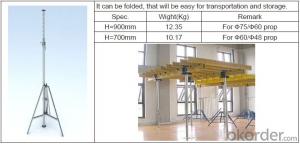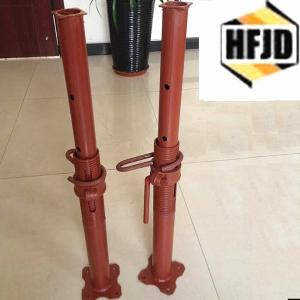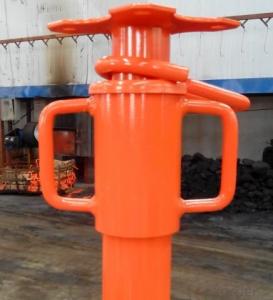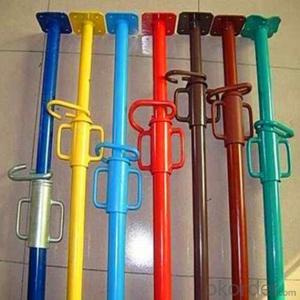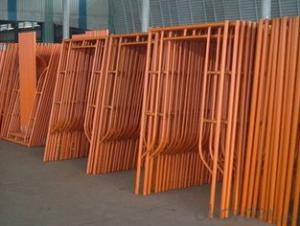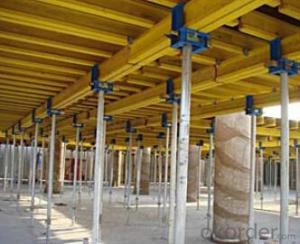Timber Beam Formwork-Climbing Formwork
- Loading Port:
- China Main Port
- Payment Terms:
- TT OR LC
- Min Order Qty:
- -
- Supply Capability:
- -
OKorder Service Pledge
Quality Product, Order Online Tracking, Timely Delivery
OKorder Financial Service
Credit Rating, Credit Services, Credit Purchasing
You Might Also Like
Thepower of the Autoclimbing Formworkis the hydraulic system, whichincludes theoil cylinder and two commutators etc. Thecommutators can control the climbing of climbingrail and the bracket. The steel rail
andthe bracket can inner-climbing, so thewhole system will climb upsteadily.
Cranesare not needed during the constructing. It is easy tooperate, highly efficient and safe. It is thebest choice for the construction of highbuildings and bridges.
Characteristics
Safety:
1.Thesystem can climbintegrallyor separately.
2.Theclimbing process is steady,synchronousand safe.
3.Excellentoperating platformhandrailand aislecanbe liftedtogetherwith the formwork.
4.Theclimbing speed is quick, which can shorten the construction period and reduce the construction cost.
- Q:Are steel props reusable or disposable?
- Steel props are typically reusable rather than disposable. Steel props are adjustable supports used in construction to temporarily hold up ceilings, walls, or other structural elements. They are made from sturdy steel materials, which make them durable and long-lasting. After their initial use, steel props can be dismantled, cleaned, and stored for future use on other construction projects. This reusability makes steel props a cost-effective and sustainable choice for construction companies. However, it is essential to regularly inspect and maintain steel props to ensure their safety and structural integrity.
- Q:Can steel props be used for supporting temporary tunnels?
- Yes, steel props can be used for supporting temporary tunnels. Steel props are commonly used in construction and civil engineering projects for providing temporary support to structures such as tunnels, bridges, and building facades. They are designed to withstand heavy loads and are highly adjustable, making them ideal for supporting temporary tunnels. Steel props offer stability, strength, and versatility, making them a reliable choice for temporary tunnel support.
- Q:How do you prevent damage to steel props during construction activities?
- There are several measures that can be taken to prevent damage to steel props during construction activities. Firstly, ensuring proper training and supervision of workers is crucial, as they need to handle the props correctly and with care. Secondly, using protective measures such as placing rubber caps on the ends of the props can help prevent scratches and dents. Additionally, regular inspections should be conducted to identify any signs of wear or damage, and prompt maintenance or replacement should be carried out when necessary. Lastly, proper storage and transportation of the props, using appropriate equipment and techniques, can also help prevent damage during construction activities.
- Q:What are the potential drawbacks of using steel props?
- Some potential drawbacks of using steel props include their weight, which can make them difficult to handle and transport, as well as their susceptibility to rust and corrosion. Additionally, steel props may require regular maintenance and inspection to ensure their structural integrity, which can add to the overall cost and effort involved in using them. They also have limited adjustability compared to other types of props, which may restrict their use in certain applications.
- Q:Are steel props suitable for use in modular construction projects?
- Indeed, steel props are a fitting choice for implementation in modular construction projects. Adjustable steel columns or steel shore props, also commonly referred to as steel props, are frequently employed in construction endeavors to offer provisional support to structures during construction or renovation. They are specifically designed to be adjustable in height, allowing for simple installation and adaptability to various construction situations. Within the realm of modular construction, which involves erecting buildings off-site and subsequently relocating them to their final destination for assembly, steel props play a pivotal role in furnishing temporary support to the modular components. These props are instrumental in ensuring the stability of the structure during transportation and installation, thereby averting any potential harm or structural failure. Steel props deliver several advantages in modular construction projects. Primarily, they possess considerable strength and robustness, capable of withstanding substantial loads and supplying the requisite stability to the modular components. This attribute is particularly significant in modular construction, as the components must endure the stresses of transportation and assembly. Furthermore, steel props possess adjustable height capabilities, enabling effortless accommodation for different floor levels or uneven surfaces. This flexibility renders them suitable for a wide array of modular construction projects, as varying heights and configurations may be necessitated. Moreover, steel props exhibit exceptional durability and longevity, enabling them to withstand the challenges posed by construction environments. Typically composed of top-grade steel, which boasts superior strength and corrosion resistance, these props are equipped to endure the rigors of modular construction projects and provide dependable support throughout the process. In conclusion, steel props are unquestionably appropriate for implementation in modular construction projects. Their strength, adjustability, and durability render them an ideal choice for furnishing temporary support to modular components during transportation, assembly, and throughout the construction process.
- Q:How do steel props compare to hydraulic shores in terms of safety?
- Both steel props and hydraulic shores are commonly used in construction projects to provide temporary support to structures. When it comes to safety, both options have their advantages and considerations. Steel props, also known as adjustable steel props or acrow props, are made of high-strength steel and are easily adjustable in length. They are known for their reliability, durability, and load-bearing capacity. Steel props are generally considered safe when used within their specified load limits and in accordance with industry guidelines. They have a proven track record of withstanding heavy loads and providing stable support to structures. On the other hand, hydraulic shores, also known as hydraulic jacks or shoring jacks, use hydraulic pressure to provide support. They offer the advantage of being able to be adjusted remotely, often from a distance, which can enhance safety and save time. Hydraulic shores can provide consistent and controlled support, making them suitable for situations where precise adjustments are required. In terms of safety, both steel props and hydraulic shores have their own considerations. Steel props may have a higher load-bearing capacity and are generally more durable, but they require manual adjustment, which can be time-consuming and labor-intensive. It is crucial to ensure that steel props are properly installed, with adequate base plates and bracing, to prevent any potential accidents or collapses. Hydraulic shores, on the other hand, are easier to adjust and offer more flexibility, but they rely on hydraulic systems that can be prone to leaks or malfunctions. Regular maintenance and inspections are necessary to ensure the hydraulic system functions properly and to prevent any potential safety hazards. Overall, both steel props and hydraulic shores can be safe and effective if used correctly and in line with industry standards. It is important to consider the specific requirements of the project, the load-bearing capacity needed, and the expertise of the construction team when deciding between these two options.
- Q:How do you dismantle steel props?
- In order to dismantle steel props, it is necessary to have a few tools and follow specific steps. Below is a comprehensive guide to assist you in the process: 1. Collect the required tools: You will require a hammer, a wrench or spanner, a pry bar or crowbar, and safety gloves. 2. Prioritize safety: Prior to commencing the task, ensure the protection of your hands from sharp edges or splinters by wearing safety gloves. 3. Loosen the nuts: Utilize a wrench or spanner to loosen the nuts on the props. Rotate the nuts in an anticlockwise direction to loosen them. If the nuts are firmly secured, you may need to exert some force or gently tap the wrench with a hammer to loosen them. 4. Remove the nuts and bolts: Once the nuts are loosened, completely remove them. Place them aside in a secure location for possible future use. Extract the bolts from the props. 5. Release tension: If the props are under tension, gradually release it by gently lowering the props. To avoid any accidents, ensure you stand at a safe distance from the props while lowering them. 6. Eliminate the props: Carefully raise the props off the ground using a pry bar or crowbar. Slide the crowbar beneath the base of the props and lift it upward to disengage it from the ground. Repeat this step for all props. 7. Store or dispose of the props: Once all props are dismantled, you can either store them for future usage or dispose of them appropriately. If choosing to store, ensure they are stored in a dry and secure place to prevent any damage or corrosion. It is important to exercise caution while dismantling steel props, as they can be heavy and mishandling them may pose a risk of injury.
- Q:What are the common applications of steel props?
- Steel props, also known as adjustable steel props or steel shore props, are widely used in construction and building projects. These props provide temporary support to various structures during construction or renovation. Here are some common applications of steel props: 1. Formwork Support: Steel props are extensively used to support formwork structures during the casting of concrete. They provide stability and load-bearing capacity, ensuring the formwork stays in place until the concrete sets. 2. Slab and Beam Support: Steel props are commonly employed to support slabs and beams during construction. They help distribute the load evenly, preventing any potential sagging or collapsing of the structure. 3. Shoring and Scaffolding: Steel props are an essential component of shoring systems used to stabilize and support excavations, trenches, and walls. They help prevent soil movement and maintain structural integrity during earthworks and foundation construction. 4. Temporary Supports: Steel props are utilized as temporary supports when removing load-bearing walls, columns, or beams during renovation or alterations. They provide a secure and adjustable solution to ensure the remaining structure remains stable while the modifications take place. 5. Temporary Roof Supports: Steel props are commonly used to provide temporary support to roofs during repairs or construction. They help maintain the structural stability of the building, especially in cases where the existing roof structure has been compromised. 6. Mezzanine and Raised Floor Support: Steel props are employed to support mezzanine floors and raised platforms, providing stability and load-bearing capacity. They help distribute the weight of the floor and any additional loads to the foundation or lower level. 7. Pipe and Duct Support: Steel props are used to support pipes, ducts, and other utilities during installation or maintenance. They prevent sagging or movement of these systems, ensuring they are properly aligned and supported. In summary, steel props find wide-ranging applications in construction projects, including formwork support, slab and beam support, shoring and scaffolding, temporary supports, temporary roof support, mezzanine and raised floor support, and pipe and duct support. Their adjustable nature, load-bearing capacity, and versatility make them a reliable choice for providing temporary support during various construction activities.
- Q:Can steel props be used in marine environments?
- Steel props have the ability to be utilized in marine environments. The strength and durability of steel make it a suitable material for various marine applications. However, it is important to take into account the possible consequences of corrosion in marine environments. When steel is exposed to saltwater, it has the potential to corrode, which can gradually weaken its structural integrity. To address this issue, steel props used in marine environments often undergo special treatments or protective measures. These treatments, such as galvanization or epoxy coatings, establish a barrier between the steel and the corrosive marine environment. As a result, the risk of corrosion is either prevented or significantly reduced. Regular maintenance and inspection are also essential to ensure the long-term performance of steel props in marine environments. Any indication of corrosion or damage should be promptly addressed in order to prevent further deterioration and uphold the safety and integrity of the structure. In conclusion, while steel props can be employed in marine environments, careful consideration must be given to the potential effects of corrosion. Appropriate measures should be taken to protect and maintain the steel props, ensuring their effectiveness and longevity in these challenging conditions.
- Q:Why subway steel support axial force value
- Calculation of axial force of steel support in deep foundation pit:The first plus zero, the calculation of a cable tension, the anchor cable tension is able to ensure the stability of the foundation pit resistance, and then on the basis of the times on the basis of the standard 70~95%.Preload is generally not more than 450kN, because of the use of pile anchor structure is mostly sand, silt, or clay, anti pulling force of this stratum and anchor is limited, 450kN means that the prestressing design tension reaches 450/0.95~450/0.7, which is basically the ultimate anchor in this ordinary formation, if not met to consider the encryption of anchor spacing.
1. Manufacturer Overview |
|
|---|---|
| Location | |
| Year Established | |
| Annual Output Value | |
| Main Markets | |
| Company Certifications | |
2. Manufacturer Certificates |
|
|---|---|
| a) Certification Name | |
| Range | |
| Reference | |
| Validity Period | |
3. Manufacturer Capability |
|
|---|---|
| a)Trade Capacity | |
| Nearest Port | |
| Export Percentage | |
| No.of Employees in Trade Department | |
| Language Spoken: | |
| b)Factory Information | |
| Factory Size: | |
| No. of Production Lines | |
| Contract Manufacturing | |
| Product Price Range | |
Send your message to us
Timber Beam Formwork-Climbing Formwork
- Loading Port:
- China Main Port
- Payment Terms:
- TT OR LC
- Min Order Qty:
- -
- Supply Capability:
- -
OKorder Service Pledge
Quality Product, Order Online Tracking, Timely Delivery
OKorder Financial Service
Credit Rating, Credit Services, Credit Purchasing
Similar products
New products
Hot products
Hot Searches
Related keywords
